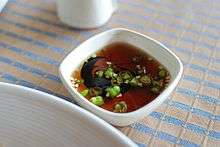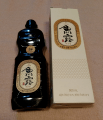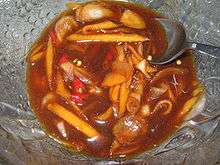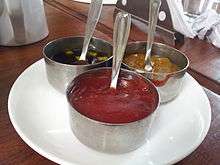Fish sauce

Fish sauce is a condiment made from fish coated in salt and fermented from weeks to up to two years.[1] It is used as a staple seasoning in various cuisines in Southeast and East Asia, particularly Indonesian, Burmese, Cambodian, Filipino, Thai, Lao, and Vietnamese. Upon widespread recognition of its ability to impart a savory umami flavor to dishes it has become embraced globally by chefs and home cooks.
Fish sauce is both added to dishes as a seasoning and used as a base in dipping sauces. The umami flavor in fish sauce is due to its glutamate content.[2]
History
Asia
Sauces made from fermented fish parts with other ingredients, such as meat and soya bean added to it, have been recorded in China 2300 years ago.[3] During the Zhou dynasty of ancient China, fermented fish with salt was used as a condiment in which soybeans were included during the fermentation process.[4][5] By the time of the Han dynasty, this had been replaced with the recipe for soy paste and its by-product soy sauce, by using soybeans as the principal ingredient,[6][7] with fermented fish-based sauces developing separately into fish sauce.[8] A fish sauce, called kôechiap in Hokkien Chinese, or kecap in Indonesia might be the precursor of ketchup.[9][10]
By 50-100BC, demand for fish pastes in China had fallen drastically, with fermented bean products having become a major trade commodity. Fish sauce, however, developed massive popularity in Southeast Asia. Food scholars traditionally divide East Asia into two distinct condiment regions, separated by a bean-fish isogloss: Southeast Asia, mainly using fermented fish (Vietnam, Thailand, Cambodia) and Northeast Asia, using mainly fermented beans (China, Korea, Japan). Fish sauce re-entered China in the 17th and 18th centuries, brought from Vietnam and Cambodia by Chinese traders up the coast of the southern provinces Guangdong and Fujian.[11]
Europe
Historically, fish sauces were widely used in ancient Mediterranean cuisine. The earliest recorded use of a fish sauce was between 4th–3rd century BC by the Ancient Greeks, who made a fermented sauce from the scraps of fish called garos,.[12][13] It is believed to have been made with a lower salt content than modern fish sauces.[14]
The Romans made a similar condiment called either garum or liquamen.[12] According to Pliny the Elder, "garum consists of the guts of fish and other parts that would otherwise be considered refuse, so that garum is really the liquor from putrefaction."[15] Garum was made in the Roman outposts of Spain almost exclusively from mackerel by salting the scrap fish innards, and then sun fermenting the flesh until it fell apart, usually for several months. The brown liquid would then be strained, bottled, and sold as a condiment. The process lasted until the 16th century, when garum makers switched to anchovy and removed the innards.[16]
Garum was ubiquitous in Classical Roman cooking. Mixed with wine it was known as oenogarum, or with vinegar, oxygarum, or mixed with honey, meligarum. Garum was one of the trade specialties in Hispania Baetica.[17] Garum was frequently maligned as smelling bad or rotten, being called, for example, "evil-smelling fish sauce"[18] and is said to be similar to modern Colatura di Alici, a fish sauce used in Neapolitan cuisine.
In English garum was formerly translated as fishpickle. The original Worcestershire sauce is a related product because it is fermented and contains anchovies.

- Two amphoras for garum
Ingredients and manufacture
Fish sauces historically have been prepared from different species of fish and shellfish, and from using the whole fish, or by using just fish blood or viscera. Most modern fish sauces contain only fish and salt, usually made from anchovy, shrimp, mackerel, or other strong-flavored, high oil fish. Some variants add herbs and spices. For modern fish sauces, fish or shellfish is mixed with salt at a concentration of 10% to 30%. It is then sealed in a closed container for up to two years.[1]
Once the original draft has been made, some fish sauces will be produced through a re-extraction of the fish mass via boiling. To improve the visual appearance and add taste, second-pass fish sauces often have added caramel, molasses, or roasted rice.[1] They are thinner, and less costly. Some volume manufacturers of fish sauce will also water down a first-press to manufacture more product.
Fish sauce that has been only briefly fermented has a pronounced fishy taste. Extended fermentation reduces this and gives the product a nuttier, richer and more savory flavor. An anonymous article, "Neuc-num", in Diderot and d'Alembert's 18th-century Encyclopédie, states: "It is said that Europeans become accustomed enough to this type of sauce".[19]
Grades
While there is no strict grading system for fish sauces, first-tapping, or first-pressing sauces are the most sought after. Some top brands are beginning to adopt the "Extra Virgin" designation and tout more artisan processes.[20][1] Second-pass or volume sauces are easily identified as they have a thin, very watery consistency.
Regional variations
Southeast Asia
Southeast Asian fish sauce is often made from anchovies, salt, and water, and is intensely flavoured. Anchovies and salt are arranged in wooden barrels to ferment and are slowly pressed, yielding the salty, fishy liquid. The salt extracts the liquid via osmosis.
Southeast Asians generally use fish sauce as a cooking sauce. However, there is a sweet and sour version of this sauce which is used more commonly as a dipping sauce (see nước chấm).
Indonesia
The Indonesian semi-solid fish paste or fermented krill terasi, the Cambodian prahok and the Malay fermented krill brick belacan or budu from liquid anchovies are other popular variations of fish sauces.
Philippines
The similar Philippine version common to Indochina is called patis. Patis, a by-product of bagoong, is nearly always cooked prior to consumption, even when used as an accent to salads or other raw dishes. Patis is also used as an ingredient in cooked dishes, including a rice porridge called arroz caldo, and as a condiment for fried fish. Patis is also used in place of table salt in meals to enhance the flavor of the food, where it can either be dashed from a dispensing bottle onto the food, or poured into a saucer and mixed with calamansi and used as a dipping sauce.
Thailand
Similar condiments from Thailand and Burma are called nam pla (น้ำปลา) and ngan bya yay (ငံပြာရည်), respectively. In Lao/Isan, it is called nam pa, but a chunkier, more aromatic version known as padaek is also used. Similar to padaek is pla ra used in Thai cuisine. In Cambodia, fish sauce is known as teuk trei (ទឹកត្រី), of which there are a variety of sauces using fish sauce as a base.
In Thai cuisine, fish sauce is used both in cooking and also served at the table for use as a condiment, for instance in noodle soups. In addition, nearly every Thai meal is served with phrik nam pla as a condiment: a mixture of fish sauce, lime juice, and chopped bird's eye chilies. Sliced garlic, and small amount of lemon juice, is often added to this sauce.
 Phrik nam pla ("Chilli with fish sauce") is served with nearly every Thai meal.
Phrik nam pla ("Chilli with fish sauce") is served with nearly every Thai meal. An assortment of prepared fish sauces in Thailand
An assortment of prepared fish sauces in Thailand
Vietnam
The variety from Vietnam is called nước mắm.[21] Two areas in Vietnam are most famous for producing fish sauce: Phú Quốc and Phan Thiết. Popular brands in the US include Mega Chef, Red Boat, 3 Crabs, Golden Boy, and Hòn Phan Thiết.[22]
Vietnamese fish sauces are made with only two ingredients: anchovies and salt. They do not have any additives like sugar, hydrolyzed protein, or preservatives.[23] Vietnamese prefer sauces without a strong smell, and transparent with a deep golden amber color. "First press" fish sauce, meaning the sauce is bottled from the first time the fermenting barrels are drained, also indicates quality. Lastly, when measuring the nitrogen level of fish sauces (N), most fish sauce on the market falls within the mid 20N range. Anything over 30N is considered high-grade, and 40N is optimal.[24]
Nước chấm is a Vietnamese prepared fish sauce that is savory, lightly sweet and salty tasting, and can be sour and spicy if lime and chili peppers are added. The main components are fish sauce, water, and sugar. In Vietnam, there is a popular food item called mắm, which is made the same way as fish sauce, except that both the fish and the liquid extract, not just the liquid, are kept. Mắm is also fermented for a shorter period than fish sauce. Mắm is either eaten as is (uncooked), or cooked in soups or stir-fries.
In January 2016, the Institute of Food Technologists published a study asserting that the "Vietnamese fish sauce added to chicken broth, tomato sauce and coconut curry reduced the amount of sodium chloride by 10-25 percent while still maintaining the perceived deliciousness, saltiness and overall flavor intensity."[25]
 A fish sauce factory in Phú Quốc, Vietnam
A fish sauce factory in Phú Quốc, Vietnam Nước mắm
Nước mắm
East Asia
China
In China, fish sauce is called yúlù (Chinese: 鱼露, literally "fish dew") and is native to the provinces of Guangdong and Fujian.
Japan
In Japan, fish sauce variations are used as a seasoning of local specialties. Ishiru in the Noto Peninsula is made from sardine and squid. Shottsuru of Akita Prefecture is mainly made from sailfin sandfish. Ikanago shoyu of Kagawa Prefecture is made from sand lance. They are often reserved for the preparation of nabemono.
- Japanese Fish sauce, Shottsuru and Ishiru'
Korea
In Korea, fish sauce is called eojang (Korean: 어장). Across the Korean Peninsula, aekjeot (Korean: 액젓, literally "liquid jeotgal"), a type of eojang usually made of fermented myeolchi (anchovy) or kkanari (sand lance), is used as a crucial ingredient in many types of kimchi, both for taste and fermentation.[26][27]
On Jeju island, eoganjang (Korean: 어간장), made of fermented godori (young chub mackerel), or jeongaengi (horse mackerel), is used as a soy sauce substitute.

 Eo-ganjang of Jeju Island
Eo-ganjang of Jeju Island
Europe
Colatura di Alici is an Italian fish sauce.
Worcestershire sauce contains fermented anchovies among other ingredients.
See also
References
- 1 2 3 4 McGee, Harold. On Food and Cooking: The Science and Lore of the Kitchen (p. 234). Scribner. Kindle Edition.
- ↑ "Archived copy". Archived from the original on 18 February 2009. Retrieved 6 September 2009.
- ↑ "Ketchup: A Saucy History - Hungry History". History.com. 2012-07-20. Retrieved 2017-04-04.
- ↑ "调料文化:酱油的由来". Big5.xinhuanet.com. Retrieved 2018-06-21.
- ↑ zh:酱
- ↑ Hsing-Tsung, Huang (2000). Joseph Needham: Science and Civilisation in China, Vol.6, Part 5. Cambridge University Press. p. 346. ISBN 0521652707.
- ↑ Hsing-Tsung, Huang (2000). Joseph Needham: Science and Civilisation in China, Vol.6, Part 5. Cambridge University Press. pp. 358–359. ISBN 0521652707.
- ↑ Kurlansky, Mark (2002). Salt: A world history. New York: Walker and Co. p. 20. ISBN 978-0-8027-1373-5.
- ↑ Lakshmi Gandhi (2013-12-03). "Ketchup: The All-American Condiment That Comes From Asia : Code Switch". NPR. Retrieved 2017-04-04.
- ↑ McGee, Harold. On Food and Cooking: The Science and Lore of the Kitchen (p. 233). Scribner. Kindle Edition.
- ↑ http://www.scmp.com/magazines/post-magazine/article/2103418/when-china-invented-ketchup-300bc-and-how-it-morphed. Missing or empty
|title=(help) - 1 2 McGee, Harold. On Food and Cooking: The Science and Lore of the Kitchen (p. 235). Scribner.
- ↑ Farnworth, Edward R. (2003). Handbook of Fermented Functional Foods. Boca Raton, Florida: CRC Press. p. 22. ISBN 0849313724.
- ↑ Grainger, Sally. "Fish Sauce: An Ancient Condiment". Good Food SAT OCT 1, 2011. National Public Radio. Retrieved 26 October 2011.
- ↑ Natural History Pliny, the Elder. LoebClassics.com
- ↑ McGee, Harold. On Food and Cooking: The Science and Lore of the Kitchen (p. 235). Scribner. Kindle Edition.
- ↑ Wilkinson, Paul (2003). "Introduction". Pompeii: The Last Day. London: BBC. ISBN 9780563487708.
- ↑ Curtis, Robert I. (1 January 1983). "In Defense of Garum". The Classical Journal. 78 (3): 232–240. JSTOR 3297180.
- ↑ Diderot, Denis. "Fish Sauce". The Encyclopedia of Diderot and d'Alembert Collaborative Translation Project. Retrieved 1 April 2015.
- ↑ How Fish Sauce Is Made - RedBoatFishSauce.com
- ↑ Robuchon, Joël (2009). Larousse Gastronomique (Updated ed.). London: Hamlyn. p. 714. ISBN 9780600620426.
- ↑ Kyle Hildebrant (2014-02-17). "Fish Sauce Taste Test, 13 Brands Compared — Our Daily Brine". Ourdailybrine.com. Retrieved 2017-04-04.
- ↑ Stanton, J. (2012-05-02). "What Are "Hydrolyzed Soy Protein" And "Hydrolyzed Wheat Protein," And Why Are They In Everything?". Gnolls.org. Retrieved 2017-04-04.
- ↑ "Everything you want to know about Phu Quoc Fish Sauce". Phuquocislandguide.com. Retrieved 2017-04-04.
- ↑ "A New Alternative to Sodium: Fish Sauce". Institute of Food Technologists. 15 January 2016. Retrieved 16 April 2018.
- ↑ The Confidentials (2016-11-01). "REVIEW | Seoul Kimchi, Upper Brook Street | Confidentials Manchester". Manchester: Manchester Confidential. Retrieved 2017-04-04.
- ↑ "Thousands prepare kimchi feast for Seoul's poor". Channel NewsAsia. Archived from the original on 8 November 2016. Retrieved 8 November 2016.
Further reading
- Cooks Illustrated (September/October 2015) "Fish Sauce Taste Test" https://www.cooksillustrated.com/taste_tests/1625-fish-sauce
- Hastings (2015) Fish Sauce a versatile ingredient that works in many cuisines http://www.journalnow.com/home_food/food/fish-sauce-a-versatile-ingredient-that-works-in-many-cuisines/article_bb1deeb7-5b92-5168-b25d-400a7cbcf30a.html
- Hildebrant (2014) "Fish Sauce Taste Test, 13 Brands Compared" from Our Daily Brine
- Murdoch (2004) Essential Seafood Cookbook Seafood sauces, p. 128–143. Murdoch Books. ISBN 978-1-74045-412-4.
- Nguyen (2008) "How to Buy Fish Sauce: A Guide" from Viet World Kitchen
- Rosen (2013) "Can Fish Sauce Be Vietnam's Champagne?" from The Atlantic
- Johnson (2015) "3 Reasons To Get A Little More Umami in your Diet" from US News health. http://health.usnews.com/health-news/blogs/eat-run/2015/10/09/3-reasons-to-get-a-little-more-umami-in-your-diet
- Prichep, Deena (26 October 2013). "Fish Sauce: An Ancient Roman Condiment Rises Again". NPR. Retrieved 5 November 2013.
- Meewes, Veronica (2015) The Fish Sauce Cookbook published by Andrews McMeel ISBN, 9781449468699
External links
| Wikimedia Commons has media related to Fish sauce. |
| Look up fish sauce in Wiktionary, the free dictionary. |
- Phu Quoc fish sauce guide from PhuQuocIslandGuide.com
- Making Vietnamese prepared fish sauce dipping sauce (nước chấm) from HungryHuy.com


